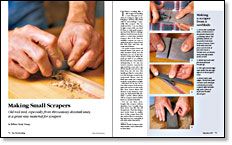Making Small Scrapers
Old tool steel, especially from throwaway dovetail saws, is a great raw material for scrapers
Synopsis: There’s nothing like a thin scraper for leveling a coat of lacquer or varnish, for easing an edge or for bringing a delicate inlay flush with its surroundings. Scrapers are easy to make from pieces of good steel that find their way into a scrap-metal drawer. In this article, William Tandy Young says talks about what saw blades he’s made them from and which steels and sizes work best. He explains how to make a scraper from a piece of old sawblade.
There’s nothing like a thin scraper for leveling a coat of lacquer or varnish, for easing an edge or for bringing a delicate inlay flush with its surroundings. I especially like scrapers that are small and thin. I can use them in tight corners with one hand if I have to. And small scrapers are much less likely to damage delicate details because they’re easier to control than standard scrapers. Best of all, these invaluable scrapers are easy to make from pieces of good steel that find their way into my scrap-metal drawer.
I’ve made scrapers from old Sawzall blades and pieces of wide bandsaw blade, but old handsaws are one of the best sources of thin steel. When the teeth get dull on an ordinary $10 dovetail saw, I don’t bother resharpening it. It’s just not worth it. Instead, I recycle the parts and buy a new saw. I tap off the handle and remove the back from the old saw. The handle gets fitted to some other tool, the back gets tossed in the scrap-metal drawer and the blade gets made into scrapers, as shown in the photos at right.
Full-sized (2 1⁄2 in. by 5 in. or 6 in.) thin scrapers, both rectangular and curved, are also available from Garrett Wade (161 Avenue of the Americas, New York, NY 10213-0459; 800-221- 2942). I prefer .40mm (about .015 in.) scrapers; they’re half as thick as a standard Sandvik.
You can use these storebought thin scrapers without alteration, but I usually chop them down just like the old dovetail saw. I find that thinner steel works better in smaller sizes. A thin scraper that’s full size tends to flex too much during vigorous use, especially if you push rather than pull it. Making a scraper from a sawblade 1. Score the sawblade with a Dremel tool or die grinder fitted with a grinding wheel. The grinding wheels are available from most hardware stores. Score both sides until the piece can be bent. If you don’t have a Dremel tool, an electric drill probably would work as well.
From Fine Woodworking #124
For the full article, download the PDF below:
Fine Woodworking Recommended Products

Tite-Mark Marking Gauge

Bahco 6-Inch Card Scraper

Veritas Precision Square






















Log in or create an account to post a comment.
Sign up Log in